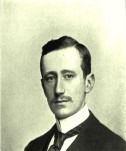Things To Make by Archibald Williams is part of the HackerNoon Books Series. You can jump to any chapter in this book here. WRESTLING PUPPETS
XXXIV. WRESTLING PUPPETS.
[Illustration: FIG. 182.—Peg marked for cutting and drilling.]
The expenditure of a halfpenny, and a quarter of an hour’s use of a pocket knife, bradawl, and pliers, will produce a toy which is warranted to amuse grown-ups as well as children. Wrestlers made out of clothes pegs may be bought for a copper or two in the street, and are hardly a novelty; yet a few notes on home production will not be a waste of space, as making is cheaper, and much more interesting, than buying.
The clothes pegs used must be of the shape shown in Fig. 182, with a round top. They cost one penny per dozen.
Drill holes through body and legs as indicated in Fig. 182. Cut the legs from the “trunk,” and whittle them to the shape of Fig. 183. The arms, made out of any thin wood, are 2-1/4 inches long between centres of end holes.
To get the best results the two arms and the four legs should be paired off to exactly the same length.
[Illustration: FIG. 183.—Clothes-peg wrestlers.]
The neatest method of attaching the parts is to use small brass tacks, which must, of course, be of somewhat larger diameter than the holes in the body. Holes in arms and legs are a loose fit, so that the wrestlers may be very loose-jointed, and the tacks must not be driven in far enough to cause any friction.
Instead of tacks one may use wire passed through the parts and secured by a bend or loop at each end. Wire has the disadvantage of entangling the thread which works the figures.
When assembling is finished, bore holes in the centres of the arm pieces, pass a piece of wire through, and twist it into a neat loop at each end. To one loop tie 2 feet of strong thread (carpet thread is best), and to the free end of the thread a large nail or hook. The other loop has 6 feet or so of thread tied to it, to be worked by the hand. If the thread is stained black, it will be practically invisible by artificial light.
The nail or hook is stuck under the edge of the carpet, or into some crack or cranny which affords a good hold, and the wrestlers are worked by motions of the hand. The funniest antics are produced by very slight jerks.
If the arms are set too close together the heads may stick between them, in which case one must either flatten off the sides of the heads or insert fresh arm wires of greater length. If a head persists in jamming against the thread wire or getting under it and staying there, cut 1/2 inch off a pin and stick it into the front of the crown, so that the head is arrested by the wire when the wrestler bends forward.
[Illustration: FIG. 184.—Large wrestlers made of stout wood.]
Large Wrestlers.—A more elaborate and realistic pair is shown in Fig. 184. The originals of the sketch are 8 inches high. Half-inch deal was used for the bodies, 3/8-inch for the legs and arms. The painting-in of hair, features, tights, and shoes adds considerably to the effect. The heads and limbs are mere profiles, but anyone with a turn for carving might spend a little time in rounding off and adding details which will make the puppets appear more lifelike.
About HackerNoon Book Series: We bring you the most important technical, scientific, and insightful public domain books.
This book is part of the public domain. Archibald Williams (2005). Things To Make. Urbana, Illinois: Project Gutenberg. Retrieved https://www.gutenberg.org/cache/epub/14664/pg14664-images.html
This eBook is for the use of anyone anywhere at no cost and with almost no restrictions whatsoever. You may copy it, give it away or re-use it under the terms of the Project Gutenberg License included with this eBook or online at www.gutenberg.org, located at https://www.gutenberg.org/policy/license.html.

